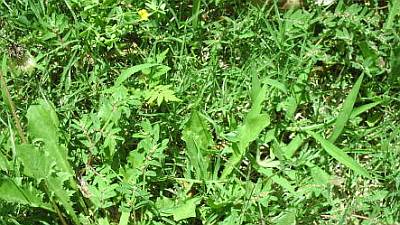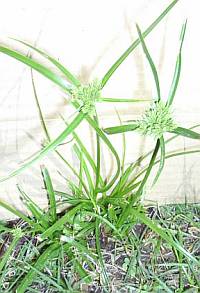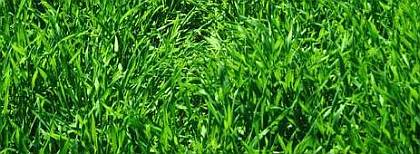ARE YOUR LAWN WEEDS WINNING?
Lawn Weeds demand a “Right Now!” solution.
The longer you wait, the more difficult your project becomes.
What herbicide products or control techniques can you use?
Why does it seem so hard to make progress against this recurring issue?
Combating weeds entrenched in grass is a rather broad topic.
Certain basic information is essential and must be broken into several categories.
Let’s start by covering the fundamentals, then present your options for treatment and plan your attack!
FTC Disclosure:
If you make a purchase via a link on this site, I may receive a small commission on the transaction - at no added cost to you.
Sponsored Links
Let’s talk about immediate action for a clear and present danger: weeds that are staring you in the face.
Does the photo below represent the condition of your lawn?
 Common Weeds in a bermuda lawn: dandelion, oxalis, spurge, crabgrass, and a tree seedling in one square foot! Does it get any worse than this? Don't give up!
Common Weeds in a bermuda lawn: dandelion, oxalis, spurge, crabgrass, and a tree seedling in one square foot! Does it get any worse than this? Don't give up!LAWN WEEDS ARE DIFFERENT
From Regular Garden Weeds
Weeds in your lawn often hide. They wait, and then when you are least prepared to deal with them, they arise, already mature and ready to reseed! At least it almost seems that way.
Actually, the weeds lurking in your grass may be the same as those in your flower bed, but the way that you can deal with them is more restrictive.
A thick layer of mulch is an effective weed control in non-lawn areas. And in an open area, a non-selective weed killer can be used, like Round-up or variations of that.
In a lawn, you must be alert to the effect of different weed killers on the grass you want to keep.
THREE BASIC CATEGORIES OF LAWN WEEDS:
BROADLEAF WEEDS.
These may have large or very tiny leaves, but they generally are rounded shapes, rather than long and slender like grass blades. Dandelions, oxalis, clover, and spurge are common examples.
GRASSY WEEDS.
As it suggests, these are plants that look like grass, with long slender blades. They may grow upright or lay flat or creep. Some are nuisance weeds to everyone. Some may be a grass variety that one person keeps for a lawn, but it is a weed to someone else. Having Bermuda grass pop up in a fescue lawn is an example.

SEDGES, or NUTGRASS.
These look a bit like grass as you can see in the photo to the right. They have a stiffer, waxy feel compared to other grasses.
The triangular shaped stem of nutgrass is very distinctive. The seed-head is quite unique, with the blades spread out like a helicopter, and topped with a substantial mound of seed hulls.This is one of the most annoying lawn weeds to try to eliminate.
Weed killers are available for all these categories. Whether or not they are safe to use on your lawn is another matter. This is why your first step is to determine which category of weed that you have.
If you want to put a name with your "favorite" weeds, or just want to be sure what category they are in, check out these resources to identify lawn weeds, and most common weeds.
If you plan to purchase a commercial product to kill lawn weeds, take samples with you. You may not get help at a discount store, but a nursery or garden department with professionals will need to see the weed in order to correctly advise you.
LAWN WEEDS:
WAYS TO GET RID OF THEM
Many people simply buy a chemical weed killer, expecting it to be the fastest or easiest way to kill lawn weeds.
Others prefer an alternative that they hope will be less toxic or damaging to their yard, the environment or themselves.
Let’s look at the options.
CHEMICAL WEED KILLER
Chemicals are handy because they can be made specific to different applications and situations. Some weed killers are non-selective, meaning they kill everything they touch. Some kill only broadleaf weeds. Others kill only grassy weeds. Or they can kill a single weed, like nut grass.
Such variety in herbicides makes them extremely useful for both the homeowner and the professional when those pesky weeds pop up each year.
But disappointment and complaints arise when people expect chemicals to be miracle products and do everything at once.
Many gardeners (even you!) hope to do as little as possible and get fantastic results getting rid of all their lawn weeds with a minimum of inconvenience. Fantasies like that leave you vulnerable to over-optimistic marketing ploys!
Chemical weed killers can play an important part in weed control. Your success depends on being educated. Learn how to select the most appropriate product and use it safely and effectively in this article:
Using Weed Killer On Lawns.
NON-CHEMICAL WEED KILLER
Every year more people look for alternatives to chemicals, for all types of chores and uses. Killing lawn weeds is an area of great concern to homeowners because of the close or frequent contact that we, our kids, and our pets have with a grass lawn.
Is the natural way an option with lawn care? We have to clarify that there can be a difference between a natural product and an organic product. For the purposes of this article, let’s consider what is available as a commercial product or as a homemade remedy.
ORGANIC WEED KILLER
Many manufacturers see the growing demand for organic products. Their products may be just called organic, or be actually certified by an organic registry, called OMRI approved or OMRI listed (pending approval). For homeowner purposes, you should be fine with either one of these types, if your goal is simply to avoid chemicals.
Unfortunately, the organic weed killers currently available are non-selective. This means they will also kill the lawn.
If lawn weeds have taken over large areas of your lawn, you might have reason to use these total-kill products.
The dead weeds, once removed, will leave bare areas that have to be reseeded. In this case, killing a bit of the old lawn with overspray may not make a big difference.
For individual weeds or smaller patches of weeds, if you use a non-selective weed killer, you must try to isolate the weed from the good grass while spraying.
Make a barrier from cardboard or plastic and formed it into a fence.
Even a soda bottle with the top and bottom cut off, can provide protection to spray the individual lawn weeds and not the grass.
NATURAL WEED KILLER
Many people have heard about home made remedies for different gardening problems, including killing lawn weeds. If this interests you, it is best to be informed before you consider it as an option that will work for you. Reduce the danger and your frustration by learning:
What to Expect From A Home Made Weed Killer.
Most natural recipes or formulas use these ingredients, either alone or as a mixture: vinegar, salt, rubbing alcohol, alcohol (liquor), citrus oil (orange or lemon), bleach, soap, boiling water.
You may notice that even though these are considered natural, as opposed to a commercial chemical product, certain common things like bleach and rubbing alcohol would certainly be potentially dangerous.
All of these suggestions for killing lawn weeds are, again, non-selective. They can kill grass as easily as weeds. There are some situations when they can be used effectively.
Perhaps this has your curiosity aroused, and you are considering using a natural product to kill weeds in areas other than your lawn. If you would like more details about using vinegar as a weed killer, check out: Vinegar, The Weed Killer.
A NATURAL METHOD TO
REMOVE LAWN WEEDS
requires the right technique!
There is one option that is not very popular, but it does work. Have you considered removing the weeds by hand-pulling or using a weeding tool? It is actually worth considering, especially in these situations:
- The density of lawn weeds is not too heavy, or the overall area of lawn is not too large.
- The time period by which all weeds must be removed is not immediate.
- The person has time available for this healthy exercise.
- Spraying chemical weed killer is not an option.
- Spraying natural weed killer that would also kill part of the lawn is not an option.
- The possibility of weeds going to seed before they can be pulled is not a factor.
As a word of encouragement, pulling weeds is often the most effective approach for long-term control, since you can get them out by the root.
Many lawn weeds can grow back when only the top growth is killed, if the root is mature enough.
Though it seems a daunting task at first, you would be surprised what can be accomplished by one or two people. Spend 15-30 minutes each evening and work your way across the yard. Skipping a TV show could be healthier for you and your lawn!
Make sure the soil is moist enough to allow the weeds to pull out easily, or for your weeding tool to penetrate the soil. Use an old serrated knife. A steak knife is good, but larger and stiffer is better.
Try a hand tool with a V-shaped blade like this common model shown. Work smart and keep it sharp with a file, because this makes all the difference for slicing through most lawn weeds.
The long-handled version of this style tool I do NOT recommend, however. After selling them for a decade, and constantly seeing them returned for breaking or coming loose at the joint connection, I figured they must get too much stress from leverage. Good concept, but needs improvement. So stick with the short handle if you look at tools in your local store.
If you need a long handled tool that is easier on your back and hands, then the Oswego GW-1, known as GRANDPA'S WEEDER, has the highest reviews from the folks using them. This is not inexpensive, yet it is less than some versions that work in a similar fashion. Consider it a one time investment versus the cost of a bottle of weed killer you will spend repeatedly.
Wear gloves, as you get a much better grip. The cotton knit gloves with latex palms are not as hot to wear as some gloves, and they work great! If, like me, you hate gloves that don't fit well, gloves that are too clumsy to do anything, gloves that are too expensive, those are just a few of the reasons why I love this type of glove. Here's a sample, and note that they are available in all sizes, for women and men: Vgo Nitrile Coating Gardening and Work Gloves, Value Pack, Choice of 4 sizes.
Now get to work! First, try pulling by hand on different types of weeds, grabbing them close to the soil so you don't break off just the top which encourages regrowth. Those with strong stems may pull out easily, including the root.
I have found that rotating a large, mature weed, either before or while I pull on it, often causes it to break free more easily. Pay attention to whether clockwise or counter-clockwise turns work better, strange as that sounds!
If the pesky lawn weeds break off at ground level, or resist pulling out, then use the knife or weed tool. Slice into the root just below the surface of the ground, and discard the weed.
Keep a bucket, bag or cardboard box handy to toss the weed into immediately. This eliminates the chore of picking up later, and prevents seeds from falling to the ground if the weed is mature.
Many types of weeding tools are available: short, medium, long models, some with fancy gimmick approaches, some as seen on TV. You might want to get those only after checking for reputable recommendations. They can sound like a good idea, until you try to use it. An ineffective or cheaply made tool will frustrate as much as the weeds!
I personally prefer to just sit and scoot across the yard as I work on an area with my trusty knife. Yet, buying a new tool is worth it, if it gets you outside in the fresh air, and is a fair trade-off for some of your expense for lawn care products. Even a lawn seat on wheels is a good idea if it eliminates your excuses!
MAKE PLANS FOR NEXT YEAR'S WEEDS
These ideas were presented to assist you with killing weeds in your grass now. Good News: You don’t have to resign yourself to doing this every year, for as long as you have a lawn!
This site is designed and being constructed to help people build a lawn that is both beautiful and healthy. A thick, lush lawn on fertile soil that is watered correctly is, by its nature, very resistant to weeds getting started or surviving.
Killing lawn weeds this season before they produce seeds is of paramount importance. Preemergent herbicides can help you get to that same point by preventing the germination of weed seeds produced the previous season. Investigate why and how to use them:
A User’s Guide To Weed Preventer Products
When To Apply Crabgrass Preventer.
Mowing and watering correctly will also make a difference by altering the growing environment in favor of grass instead of weeds. Mow high and water infrequently, since weeds like to start in moist spots with exposed soil where the sun reaches in.
Sponsored Links

BRING ON SPRING!
A Stronger, Greener Lawn
Starts Now...
with help from DoMyOwn
Products * Videos * Schedules * Guides
RELATED ARTICLES:
Photo Galleries to Identify Lawn Weeds
Weed Killer: Selecting & Using Chemical Products
Go to Top of Page
Go to Home Page of Lawn Care.
